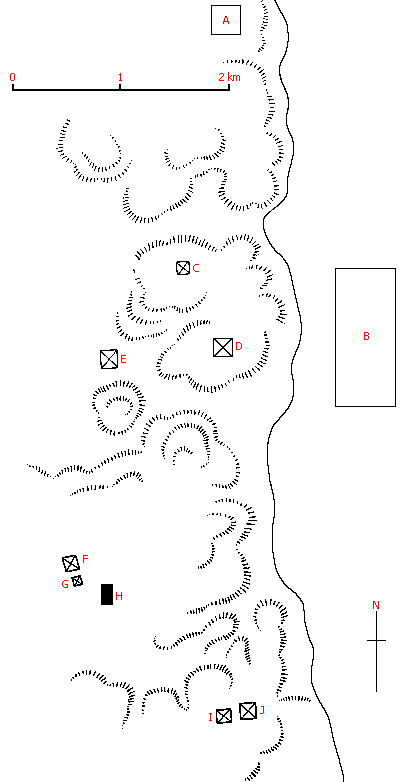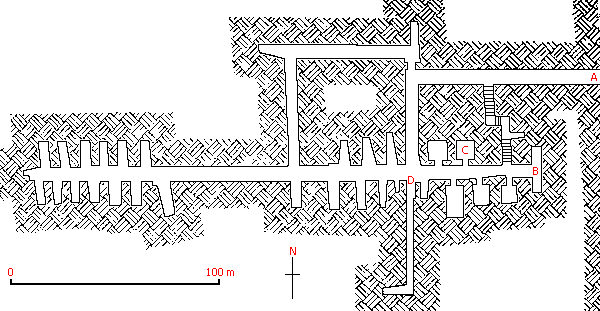![]()
Saqqara Necropolis
|
Site (29o51' N 31o14' E), of the principial necropolis of the ancient city of Memphis, situated some 17 km from the Giza, which was in use from the Ist Dynasty to the Christian period (AD 395-540). The entire length of the site is about six kilometers, with a maximum width of about 1.5 km. It has been suggested that the name of the site may be derived from that of the god Sokar. The importance of the Saqqara necropolis is indicated by very crowded nature of the burials, with some having been re-used many times and most having been extensively plundered throughout antiquity. The Ist Dynasty ruler Narmer is the earliest king whose name is known from Saqqara; a stone bowl bearing his name was discovered in one of the extensive storerooms beneath the Step Pyramid of Djoser. It is not impossible that there was originally also a monument of the reign of Narmer at Saqqara, since slightly later Ist Dynasty mastaba tombs are well attested at the site, forming a distinct group along the northeastern edge of the plateau. Building of the Step Pyramid was the first time that stone architecture had been used on such a large scale in Egypt. Mastaba tombs were constructed at Saqqara for the Memphite elite during the Old Kingdom, many of them focusing closely on the pyramids of the kings, which date from Djoser to the XIIIth Dynasty monument of Khendjer. In the New Kingdom many tombs of nobles were build at Saqqara necropolises. These tombs are date between Akhetaten (XVIII Dynasty) and Ramesses II (XIX Dynasty). There was also New Kingdom activity in northwestern Saqqara, in the form of the hypogea of the sacred Apis bull, which began to the buried in the underground galleries of the Serapeum from at least the time of Amenhotep III until the Roman Period. Private tombs of post New Kingdom date XXVIth and XXVIIth Dynasties are also located near the pyramid of Unas.Tombs of the XXXth Dynasty and Greco-Roman Period are clustered mainly on the northern side of the Step Pyramid, and towards the Serapeum. |
||
|
|
||
|
|
||
A - Step Pyramid Complex of Djoser |
1 -
S3507 - Queen Herneith ? [Den] (44.35 x 22.25 m) 2 - tomb X (26 x 12 m) [Den] 3 - S3506 (47.6 x 19.6 m) [Ist Dynasty] 4 - S3505 - Merka [Qa'a] (65 x 37 m) 5 - S3504 - Sekhemka [Djet] (56.45 x 25.45 m) 6 - S3503 - Seshemka [Merytneith] (42.6 x 16 m) 7 - S3500 (37.1 x 23.35 m) [Qa'a] 8 - S2185 [Ist Dynasty] 9 - S2105 [IInd-IIIrd Dynasty] 10 - S3471 [Djer] (41.3 x 15.15) 11 - S3357 [Hor-Aha] (48.2 x 22 m) the earliest mastaba known on the necropolis 12 - S3338 [Andjib] (37 x 13.85 m) 13 - S3120 [Ist Dynasty] 14 - S3121 [Ist Dynasty] 15 - S3035 - Hemaka [Den] (57.3 x 26 m) 16 - S3036 - Ankhka [Den] (41 x 22 m) 17 - S3038 - Nebetka [Den] (22.7 x 10.55 m) 18 - S3111 - Sabu [Andjib] (29.20 x 12.05 m) 19 - S3041 [Ist Dynasty] |
20 - mastaba of Ptahhotep 21 - mastaba of Ty 22 - mastaba of Mereruka 23 - mastaba of Kagemni 24 - mastaba of Ankhmahor 25 - tomb of Aper-el 26 - mastaba of Khenut 27 - mastaba of Nebet 28 - mastaba of Idut 29 - mastaba of Khnumhotep and Niankhkhnum 30 - tomb of Horemheb 31 - tomb of Maya |
|
|
||
 |
South Saqqara A - monastery of Apa Jeremias
|
Serapeum
|
The
buildings associated with the cult of the Apis bull or that of the later
syncretyc god Serapis. The Serapeum at Saqqara consists of a series of
catacombs to the northwest of the Step Pyramid of Djoser. The Serapeum was
excavated in 1851 by August Mariette, who was led to the site through his
discovery of traces of some of the sphinxes lining the dromos (sacred way),
which are faithfully described by the Strabo. The catacombs date back at
least as early as the XVIIIth Dynasty and continued in use
until the Ptolemaic Period. They contain many massive granite sarcophagi
weighing up to 80 tons, although all but one had been robbed of their
burials. |
||
 |
A - entrance B - burial made under Cambyses C - burial made under Amasis D - last Apis burial of the XXX Dynasty |
|
![]()
|
Copyright © 2000-2013 Dariusz Sitek, Czestochowa - Chicago - Ann Arbor |